What is Jade?
Jadeite and nephrite are materials that have both been called "jade" for thousands of years.
Author: Hobart M. King, PhD, GIA Graduate Gemologist
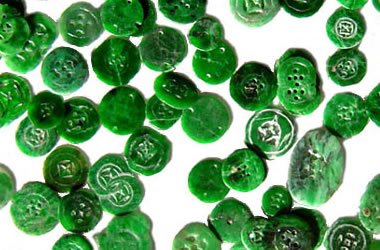
Green Jadeite Buttons: Hand-made, antique Chinese jadeite buttons showing the typical color of quality green jadeite. The jadeite in these buttons was most likely mined in Burma (the Union of Myanmar today). This photo was taken by Gregory Phillips and is distributed under a GNU Free Documentation License.
What is Jade?
"Jade" is a cultural term used for a very durable material that has been fashioned into tools, sculptures, jewelry, gemstones, and other objects for over 5,000 years. It was first used to manufacture ax heads, weapons, and tools for scraping and hammering because of its toughness.
Then, because some specimens had a beautiful color and could be polished to a brilliant luster, people started to use jade for gemstones, talismans, and ornamental objects. Although most people who think of jade imagine a beautiful green gemstone, the material occurs in a wide variety of colors that include green, white, lavender, yellow, blue, black, red, orange, and gray.
Table of Contents

Jade Ax: A reproduction of a Mayan or Aztec ax head. Photo copyright iStockphoto / Stacy Brogan.
Are All Jades the Same?
Originally, all jade objects were thought to be made from the same material. However, in 1863 a Frenchman, Alexis Damour, discovered that the material known as "jade" could be divided into two different minerals: jadeite and nephrite.
Because these two materials can be difficult to distinguish, and because the word "jade" is so entrenched in common language, the name "jade" is still widely used across many societies, industries, and academic disciplines.
In this article, the word "jade" will be used for undifferentiated materials. "Jadeite" or "nephrite" will be used when the identity of the material is known. The word "nephrite" is also an imprecise term. It is used for materials composed of the minerals actinolite and tremolite.
Physical Properties: Jadeite and Nephrite | ||
Jadeite | Nephrite | |
| Chemistry | Silicate - pyroxene. | Silicate - amphibole. |
| Color | Usually various shades of white to dark green, sometimes gray, pink, lilac, red, blue, yellow, orange, black, colored by impurities. | Usually ranges in color between white, cream, and dark green. |
| Streak | Colorless. | Colorless. |
| Luster | Vitreous to sugary. | Vitreous, greasy, silky, waxy. |
| Diaphaneity | Translucent to opaque. Rarely semi-transparent. | Translucent to opaque. Rarely semi-transparent. |
| Cleavage | Usually not seen because of a small grain size and splintery fracture. | Prismatic but usually not seen because of a small grain size and splintery fracture. |
| Mohs Hardness | 6.5 to 7 | 6 to 6.5 |
| Specific Gravity | 3.3 to 3.5 | 3.0 to 3.3 |
| Diagnostic Properties | Refractive index, toughness, hardness, specific gravity, grain size and habit. | Color, toughness, hardness, specific gravity, grain size, and habit. |
| Chemical Formula | NaAlSi2O6 or Na(Al,Fe3+)Si2O6 | Ca2(Mg,Fe)5Si8O22(OH)2 |
| Crystal System | Monoclinic. | Monoclinic. |
| Refractive Index | 1.66 to 1.68 (1.66 spot) |
1.60 to 1.63 (1.61 spot) |
| Uses | Jewelry, ornaments, tools, weapons, gemstones. | Jewelry, ornaments, tools, weapons, gemstones. |
Jadeite, Nephrite, and Science
Jadeite and nephrite have distinctly different mineral compositions. Jadeite is an aluminum-rich pyroxene, while nephrite is a magnesium-rich amphibole. However, the two minerals have very similar physical properties in the eye of the average person.
Only trained observers with significant experience are able to reliably differentiate them without mineral testing equipment. This is why jadeite and nephrite were not properly distinguished by scientists until 1863.
Experienced gemologists can easily separate jadeite from nephrite in small polished items such as beads and cabochons. There are significant differences in their refractive index and specific gravity.
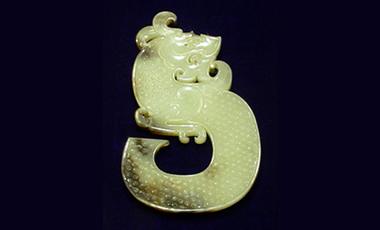
Jade Dragon: Hand-made jade dragon from the Western Han Dynasty (202 BC - 9 AD). This photo was taken by Snowyowls and is distributed under a Creative Commons license.
Jadeite, Nephrite, and Artisans
Chinese craftsmen have been producing jade objects for over 5,000 years. A few hundred years ago, master Chinese craftsmen who worked with jade daily recognized that some of the jade obtained from Burma (now the Union of Myanmar) was different. It was harder, denser, worked more easily, and produced a higher luster upon polishing. It gradually became the form of jade preferred by Chinese artisans and the jade most highly prized by the Chinese people. They realized this long before scientists differentiated jadeite and nephrite in 1863.
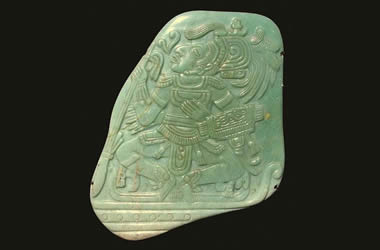
Mayan jadeite: Hand-made Mayan jadeite pectoral from the Mayan Classic period. This photo was taken by John Hill and is distributed under a GNU Free Documentation License.
Unknowingly, Chinese craftsmen had distinguished jadeite from nephrite and appreciated it enough to pay premium prices for jadeite. However, they didn't have the knowledge and equipment of chemistry and crystallography to distinguish them in a formal way.
Rarely, the Chinese craftsmen encountered fine-grained jadeite with a bright translucence and a rich, uniform green color. This beautiful material was given the name "Imperial Jade" and regarded as the stone of highest quality. At that time in China, ownership of Imperial Jade was reserved only for the Emperor. Now, anyone who can afford it can own Imperial Jade. The best specimens can cost more per carat than high-quality diamonds.
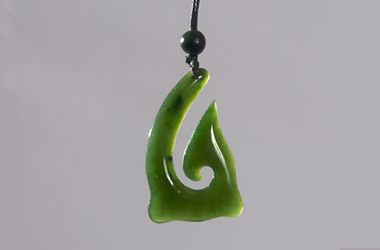
Pendant of Green Nephrite: A pendant made from a green nephrite known in New Zealand as "Maori Green Stone" or "Maori Jade." Photo copyright iStockphoto and Steve Patterson.
Jade Types and Treatments
For thousands of years, the people who manufacture and sell jade objects have found many ways to improve their appearance. Heat, wax, dye, bleach, acid, polymer injection and other treatments have all been used to improve the color, luster and stability of jadeite and nephrite. Although many of these treatments are part of traditional jade manufacturing processes, today’s serious buyers of jade want to know about all treatments that were used in the manufacturing process.
Commercial jadeite objects are placed into three "types" according to the treatments that have been used during the manufacturing process. They are designated as Type A, Type B and Type C jadeite.
Type A Jadeite
Type A jadeite objects have been treated with a coating of wax. This is the most traditional jadeite treatment. It is expected and accepted by serious buyers and generally does not impact the value of a jadeite object. In this treatment, manufacturers boil finished jadeite objects in water to clean them and prepare them for an application of wax. The objects are then dried and dipped into molten wax. The wax fills any surface-reaching pores and fractures. When the objects have cooled, excess wax is removed and the objects are buffed to a bright luster. The wax fills surface irregularities and gives the object’s surface a smooth, lustrous finish.
Type B Jadeite
Type B jadeite objects have been bleached by soaking in hydrochloric or sulfuric acid. The acid removes oxidation stains and leaches out sodium. This lightens the color of many materials. Pressure is then used to impregnate the jadeite with wax or a clear polymer resin. Impregnation fills all surface-reaching pores and fractures and gives the object an improved smoothness, luster and color.
Unfortunately, the appearance of Type B jadeite objects can begin to deteriorate in just a few years. Acid treatment makes some jadeite brittle, and polymer resins can discolor with time or exposure to heat and sunlight. Because of these problems, Type B jadeite treatment should always be disclosed when an object is sold, but many items are sold without disclosure. This lack of disclosure is because Type B jadeite objects normally sell for a small fraction of the price paid for a similar Type A object. Sellers often get away with nondisclosure because Type B treatments are difficult to detect. Testing at a gemological laboratory is often required for detection of Type B treatments.
Type C Jadeite
Type C jadeite usually has all of the treatments of Type B jadeite, but the object has also been dyed to a more desirable color. The dyes can fade over time or with exposure to heat and light. For these reasons, Type C treatments should always be disclosed.
Dye treatment can often be detected by examination with a microscope, spectroscope or gemological filters, but this testing should not be needed - the seller should disclose the full extent of treatment for every object that is sold. Disclosure doesn’t always happen because Type C jadeite sells for a small fraction of similar objects with Type B treatment.
Type C objects should be purchased for a price that assumes temporary use for a few years. Anyone who spends the serious money on jade should know the difference between jadeite and nephrite, have a good knowledge of jadeite treatments, how they impact value, and how they impact future durability and appearance. Confirmation of the jadeite type by a gemological laboratory is a good idea for expensive items. These services are easy to obtain and usually cost a tiny fraction of what is paid for a Type A jadeite item.
Jade Misnomers
A "misnomer" is an incorrect name. In the gemstone trade many misnomers have been given to materials that look like a more popular or more valuable material even though that name is incorrect. The use of a misnomer can be innocent or derogatory, but the intent is often to associate a product with one that is much more popular or more valuable. Even when done without deceptive intent, the practice can be confusing or misleading to many buyers.
An example of a jade misnomer is the use of the name "Mexican jade" for the green-dyed calcite or travertine that is commonly used to produce vases, chess pieces, desk sets and other ornamental objects. Use of the name by a seller in the presence of potential customers can be misunderstood or deceptive.
In July 2018, the Federal Trade Commission of the United States published a new edition of their Guides for the Jewelry, Precious Metals, and Pewter Industries. In those guides they state that the use of an incorrect varietal name can be "misleading", "unfair", and "deceptive". Today sellers who continue using these incorrect names could face legal action. For more information, see our article about "green amethyst" and "yellow emerald". A few of the many jade misnomers are listed below.
- "African Jade" - a massive variety of green grossularite garnet found in the Transvaal Province of South Africa
- "Amazon Jade" - amazonite, a blue-green microcline feldspar
- "American Jade" - californite, a variety of vesuvianite
- "Bowenite Jade" - a variety of serpentine resembling nephrite
- "Garnet Jade" - a massive variety of green grossularite garnet
- "Honan Jade" - a name used for a variety of jade substitutes including jade in quartz, serpentine, soapstone
- "Mexican Jade" - green-dyed calcite or greenish travertine
- "Indian Jade" - aventurine quartz
- "Korean Jade" - a variety of jade look-alikes including glass, soapstone and serpentine
- "Manchurian Jade" - soapstone
- "Oregon Jade" - green jasper, green grossularite or other jade look-alikes found in Oregon
- "Serpentine Jade" - varieties of serpentine that look like jade
- "Soochow Jade" - name used for a variety of jade substitutes including jade in quartz, serpentine, soapstone
- "South African Jade" - green grossularite found in the Transvaal Province of South Africa
- "Transvaal Jade" - green grossularite found in the Transvaal Province of South Africa
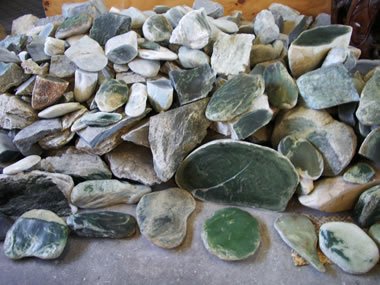
New Zealand Greenstone: These boulders, harvested from glacial outwash on the South Island of New Zealand, were originally called "Pounamu" by the local Maori people, then "greenstone" (a literal translation) by European explorers. They are actually nephrite jade. They were used by the Maori for making tools and weapons. Pieces with an attractive color or pattern were used to make ornaments and fashioned into pendants. Public domain image by Sarang.
Early Use of Jade in Tools
People have used jade for at least 100,000 years. The earliest objects made from jade were tools. Jade is a very hard material and is used as a tool because it is extremely tough and breaks to form sharp edges.
Most jade does not have a color and translucence that is expected in a gemstone. However, when early people found these special pieces of jade, they were often inspired to craft them into a special object.
"Toughness" is the ability of a material to resist fracturing when subjected to stress. "Hardness" is the ability of a material to resist abrasion. Early toolmakers took advantage of these properties of jade and formed it into cutting tools and weapons. It was used to make axes, projectile points, knives, scrapers, and other sharp objects for cutting.
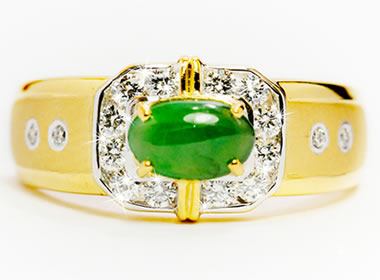
Translucent Green Jade: A translucent green jade cabochon with beautiful color, set into a gold ring and surrounded by small diamonds. Photo copyright iStockphoto / Biggereye.
Use of Jade as a Gemstone
Jade is a durable, colorful material that can be worked into shapes and given a high polish. These properties make it a very desirable gemstone. Jade has been used to make a variety of jewelry items such as pendants, necklaces, rings, bracelets, earrings, beads, cabochons, tumbled stones, and other items.
These jewelry items are often made of solid jade, combined with other gems, or placed in settings made from gold, silver, or other precious metals. In addition to jewelry, jade is used to make small sculptures, ornaments, religious art, and small functional objects.
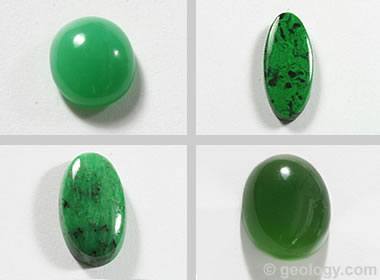
Commonly Confused With Jade: Pictured here are four gems commonly confused with jade. From top left and going clockwise they are chrysoprase, maw sit sit, serpentine, and hydrogrossular garnet. They have a color, luster, and translucence that is known to occur in jade.
Materials Confused With Jade
A number of other minerals and materials that are commonly cut and polished are easily confused with jade. All of these materials can have a color, luster, and translucence that is very similar to jade - so similar that the average person is unable to recognize them. These materials are often used to manufacture cabochons, beads, and other objects in the same style as jade. They sometimes enter the market with and without disclosure. They are often marked with the name "jade" or with one of many misnomers.
Chalcedony is a translucent variety of microcrystalline quartz that occurs in a range of colors similar to jade. Chrysoprase is a bright green chalcedony colored by chromium that, when cut into cabochons, beads, and small sculptures, will look very similar to jade. Chalcedony occurs in a variety of other translucent colors such as black, lavender, yellow, and orange that can look like the color varieties of jade. Chalcedony can be a very close gemstone look-alike with jade. It can be differentiated from jade using is lower specific gravity and by a variety of instrumental methods.
Serpentine occurs in a variety of wonderful translucent to nearly transparent green and yellowish green colors that look very much like jade. It is a metamorphic mineral that is often found in the same geographic areas and same types of rocks as jade. Serpentine is significantly softer than jade and also has a much lower specific gravity.
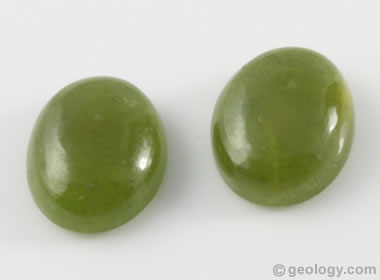
Vesuvianite has a color and a greasy luster that fool unknowing people into thinking it is nephrite.
Vesuvianite, also known as idocrase, is another jade look-alike that is very difficult to distinguish from jade without laboratory testing. It has similar hardness, specific gravity, and physical appearance. Vesuvianite is not nearly as tough as jade and will break more easily - but that requires destruction of the specimen.
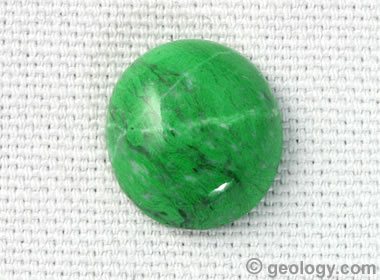
Maw Sit Sit is a rock composed of jadeite, albite, and kosmochlor (a mineral related to jadeite). It has a bright chrome-green color and accepts a bright polish. For those reasons it is used as a gemstone. Maw sit sit was first properly identified in 1963 near the village of Maw Sit Sit in northwestern Burma in the foothills of the Himalayas. This is the only location where it has been discovered to date. It is used to cut cabochons and produce small sculptures. Because of its scarcity and low production, it is rarely seen in jewelry.
Maw Sit Sit is a rock with a bright chrome-green color mined in Myanmar. It has a very similar appearance to jade. Maw sit sit is composed of jadeite, albite, and kosmochlor (a mineral related to jadeite). It is used to cut cabochons, beads, and make small sculptures, and is easily confused with jade.
Hydrogrossular Garnet is a green massive variety of garnet that is usually green in color with black markings. It looks so much like jade that in South Africa, where it is common, it is known as "Transvaal Jade." It is frequently cut into beads, cabochons, and small sculptures.
Aventurine is a trade name used for a green quartz that is often colored by fuchsite inclusions. These typically color the quartz a light to dark green color and produce some aventurescent sparkle. Aventurine is sometimes confused with jade. It is sometimes referred to by the misnomer of "Indian Jade."
All of the above natural minerals and rocks can be confused with jade. Many people like them, enjoy them, and knowingly purchase them for that reason. It is important to know that these jade look-alikes, along with plastic and glass made into objects in the same style as jade, are abundant in the market place. Know what you are buying, or purchase from a dealer you can trust if you are shopping for these items and desire jade instead of an alternative. Errors and deception are common.
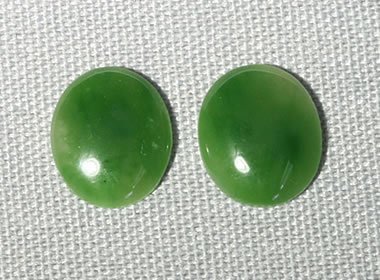
British Columbia jade cabochons: A pair of translucent cabochons cut from bright green British Columbia nephrite. Approximately 10 x 12 millimeters in size. Today, tons of jade are mined in British Columbia and shipped to China, where both demand and prices are higher than in western Canada.
Geography of Jade
Most people immediately think of China as the source of jade and jade objects. China has always been an important producer of jade, a leading jade cutting center, jade consumer, and jade market. The only time dominance in these activities moved outside of China was between World War II and the early 1980s. At that time the Chinese government suppressed jade commerce, and Hong Kong temporarily became the center of jade commerce.
Jade jewelry and jade artwork are extremely important in China. Jade is more important in China than the importance of diamonds in the United States. Per-carat prices for the best imperial jade in China rival the per-carat price paid for diamonds in the United States.
Since prehistoric times, jade has been used to make tools, weapons, and important ornamental objects in Asia, Europe, Australia, North America, South America, and numerous Pacific islands. The toughness of jade made it an excellent material for making tools and weapons.
Because of its beauty, people held jade in highest esteem and used it to make religious art and ornaments for their rulers. None of these ancient cultures had contact with one another, yet they all independently used jade for many of their most sacred and important objects. Such is the appeal of jade.
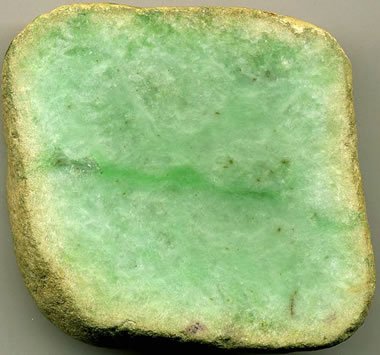
Green Jadeite Boulder: An alluvial boulder of green jadeite with a brown weathering rind from northern Burma. This boulder is about 6 centimeters across. Photo by James St. John, used here under a Creative Commons license.
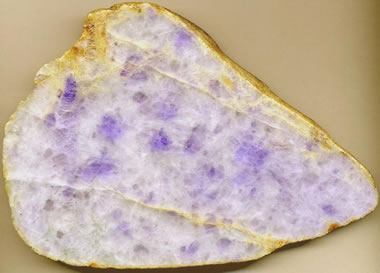
Lavender Jadeite Boulder: An alluvial boulder of lavender jadeite with a brown weathering rind from northern Burma. This boulder is about 18 centimeters across. Photo by James St. John, used here under a Creative Commons license.
Geologic Occurrence and Prospecting
Jadeite and nephrite are minerals that form through metamorphism. They are mostly found in metamorphic rocks associated with subduction zones. This places most jadeite and nephrite deposits along the margins of current or geologically ancient convergent plate boundaries involving oceanic lithosphere.
Jadeite is typically found in rocks that have a higher pressure origin than nephrite. This normally causes a geographic separation of jadeite and nephrite deposits.
From ancient times, much of the prospecting for jade has been done in the steeper parts of drainage basins, where pebble- to boulder-size pieces of rocks are found in stream valleys. Boulders and pebbles of jade normally have a brown weathering rind that hides their inner beauty and potential value.
Prospectors search these valleys looking for jade boulders. Small windows are often cut into the boulders in the field to assess the material's quality and to determine if it is worth the labor of transport.
Jade boulders can be very difficult to transport without damage. Human and animal labor was the only way to transport them historically. Today in some areas that is still the only way to move the boulders to market. Where economics allow, a helicopter with a basket or sling on a cable will fly in to difficult areas. Workers on the ground will prepare the boulders for lifting, and the helicopter will fly them out. Although helicopters are very expensive to use for this type of work, one nice boulder can be worth many thousands of dollars or more in rough form.
Some jade is also mined from hard rock deposits. Boulders are sometimes mined from ancient conglomerates, but ophiolite exposures are the most important type of hard rock deposit. Ophiolites are the metamorphosed rocks of ancient subduction zones, now exposed at the surface by faulting or uplift, followed by exhumation by weathering. Jade is mined from ophiolites by both surface and underground methods.
Geographically, much of the world's jade is found around the rim of the Pacific Ocean, where subduction transports large slabs of oceanic lithosphere beneath continents and volcanic island arcs. This accounts for much of the jade found in South America, Central America, the United States, Canada, eastern Asia, and New Zealand.
Perhaps the most attractive and valuable jade found in the United States is from the area around Jeffrey City and Crooks Gap in Wyoming. There, nephrite jade is found by prospecting alluvial sediments, looking for jade in stream-rounded pebble- to boulder-size pieces.
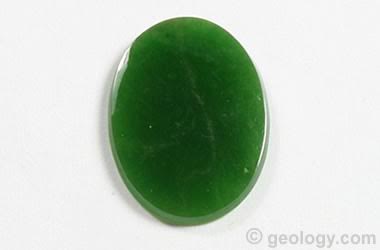
Wyoming Jade: A nice oval cabochon cut from Wyoming jade. This cabochon was cut from a thin slab of jade only a few millimeters thick to conserve material and produce a translucent stone.
| Jade Information |
|
[1] Guides for the Jewelry, Precious Metals, and Pewter Industries, proposed revisions; Federal Trade Commission; 16 CFR Part 23, 2015. Link to excerpt.
|
Social Importance of Jade
In the United States and Europe, diamonds, rubies, sapphires, emeralds, opals, garnets, and a few other gems are much more popular than jade. Jade is not thought to be as precious in these regions as it is in China.
The Chinese have a much higher regard for jade than any other people. For thousands of years, jade has been the most popular gemstone in China. Chinese emperors desired excellent specimens of jade, and they traded or waged war with distant people to acquire them.
In China, gifts made from jade are given at almost every important station in life, such as birthdays, anniversaries, marriages, and other celebrations. It is also a commonly used material for producing religious art. China is the country where the importance of jade is the highest.
| More Gemstones |
 |
Birthstones |
 |
Gifts That Rock |
 |
Diamond |
 |
Polka Dot Agate |
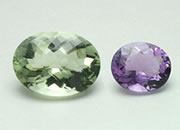 |
Prasiolite |
 |
Bloodstone |
 |
Blue Gemstones |
 |
Tourmaline |

Find Other Topics on Geology.com:

|

| ||

|

| ||

|

| ||

|

|

